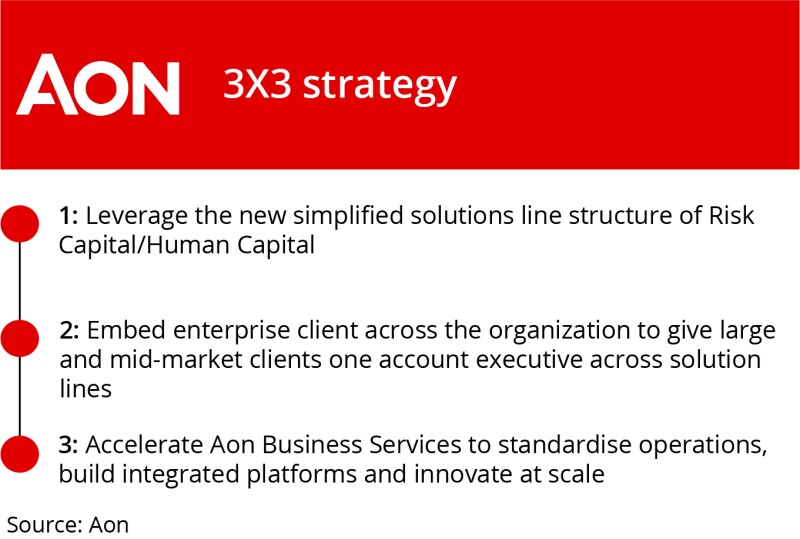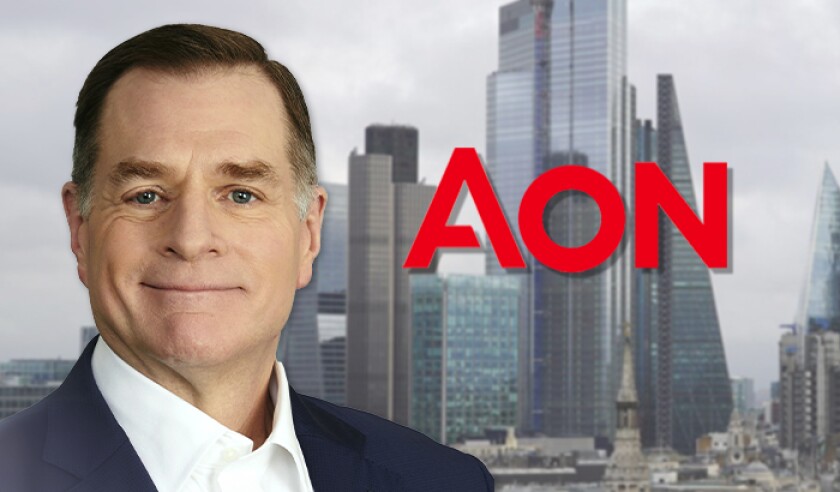Speaking after the so-called 3x3 strategy was unveiled, which will involve a ~$900mn charge, the long-serving Aon CEO said: “This is about a set of actions over the next three years which substantially accelerate progress and put us in a position to continue building momentum.”
He continued: “Exceptional financial performance will come from delivery of these three commitments as a derivative outcome, not as the primary focus.”
Driving increased margins over time creates more operating leverage in the business, he said. “The outcome of that is an evolving capital application around the world that’s different than what we have now. It opens up the ability to think about capital more broadly.”

Case emphasized that the strategy has emerged from the escalation of the forces that shaped its 2010 Aon United strategy, with the world becoming riskier.
He said we have seen “a profound set of transitions that require a big set of answers” – pointing to increased geopolitical tensions, the pandemic and its impact on workforce questions, climate change, and disruption to established trade patterns.
This represents a threat to industry relevance, he went on. “To reduce that trend is going to need a meaningful set of integrated views to help clients. And these are the forces that really set up the industry’s battle for relevance.”
“We could have just kept on our current path and made progress every year, but we decided to go further, faster,” he said, adding that it will focus on scaling its existing strategy to deliver improved client leadership, service experience, and increased innovation.
Drilling down, Case addressed the escalating challenges in property cat and mounting concern in some corners of the industry around US casualty loss cost inflation. “And the problem is that’s not a total cost of risk problem, that’s a return on capital problem – and so it’s going to go beyond the risk buyer.”
“They’re going down the hall to talk to the Treasurer and the CFO. It’s a different conversation and that’s why you have to come back with an integrated set of solutions. That isn’t just ‘here’s your placement’ - it really is connecting risk to capital.”
He predicted that the pressure these changes are creating will only become more intense in the coming years.
“Certain segments might become attractive to us”
Aon has been a major margin story over the last decade-plus, driving a ~1100-bps improvement in operating margin, and Case stressed that one of the derivative financial impacts of the new plan would be additional margin growth.
But the margin growth does not reflect extracting additional economics for shareholders, he said. “When we create new value for clients, we’re also creating value for our shareholders.”
Referencing the creation of a parametric bond for a tech company that pays out to their staff in case of a hurricane, Case argues this type of content and capability changes the calculus on value for clients and shareholders, “because we have a better, more valuable answer.”
Alongside the impact of increased operating leverage, Case stressed that the end of “free money” had changed market dynamics. “So certain segments might become attractive to us that weren’t attractive before.”
Case declined to address prior reporting from this publication that Aon has stepped up its search for an acquisition or acquisitions that will allow it to enter the US mid-market and US wholesale segments. (For background see: “Aon steps up search for major US acquisition” and “Aon: The moment for dealmaking”)
However, he argued that the central reasons for the 3x3 plan were client reasons. “Most importantly of all, by doing this, we are going to have tools and capabilities with our clients that we think they need and are unique,” he said.
“Organisations are people”
Aon under Case’s leadership has become known for frequent evolution of its operating model and structure, including most dramatically via its Aon United programme that saw the creation of a single brand, single P&L, and single executive leadership team.
Pressed on the idea that the 3-year plan was focused around mechanical changes to the group, Case pushed back. “Organisations are people. People and culture are enormously more powerful than any strategy in the world,” he argued, stressing that much of the last decade had been spent building a unified culture.
He also rejected the idea that the organisation might suffer from change fatigue. “The second piece is change doesn’t create fatigue. Change without impact creates fatigue. Change that drives impact creates energy.”
Change doesn’t create fatigue – change without impact creates fatigue
Referencing tech firms that are constantly changing themselves and driving hard, Case said: “they’re on a mission that they feel has impact. For us, it’s matching capital with risk in a way that reduces volatility in the world.
“When you really wire that up, and you have impact at a client level, that’s energy. And we’re enabling more energy.”
The Aon 3x3 strategy graphic has been updated to clarify that the strategy comprises three commitments over three years, not one commitment per year.


